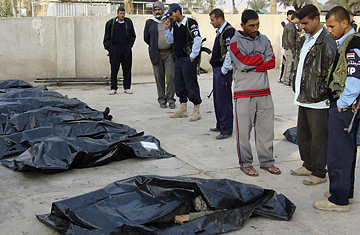
men stand over the bodies of five men killed in Baquba, Iraq, in December.
The five severed heads left on a road leading to Baquba each bore a message written in blood, a warning in Arabic to would-be volunteers for the new grassroots security forces supported by the Americans: "Join the concerned citizens and you will end up like this."
Residents in the area found the mutilated remains Monday, according to Maj. Gen. Mark Hertling, the commander of U.S. forces in northern Iraq. Speaking to reporters in Baghdad, Hertling also showed U.S. documentation of another brutal murder in the Baquba area, where U.S. forces have in recent days launched a major offensive aimed at routing extremists who have been terrorizing the territory for months. Grainy video from a flying drone showed several men emerge from a car parked in a field. The figures opened the trunk and pulled out a struggling victim, who was then thrown into a ditch and shot multiple times.
"This is one of four videos I have personally viewed in the last three weeks demonstrating the nature of the enemy we face," Hertling said. "In one of those videos, which we decided not to show today, after the terrorists shot the individual and left him in the ditch, they then beheaded him."
The Baquba killings will become part of the disparate statistics and numbers being amassed and studied to tally Iraq's official civilian death toll, a body count that has drawn widely differing estimates. On Wednesday, the World Health Organization (WHO) released a new study saying that roughly 151,000 Iraqi civilians died violently during the three years following the U.S. invasion. The new U.N. report marks the most comprehensive effort thus far to document civilian deaths in Iraq, where reliable statistics are scant.
The WHO death toll represents a rough average based on a survey of nearly 10,000 households. The low estimate for the study totaled 104,000 civilian deaths, with the high figure reaching 223,000. Both tallies were well below the 600,000 estimate put forward in a disputed 2006 John Hopkins University study, which surveyed far fewer households. But the new U.N. total rose significantly above the most widely cited running tally by Iraq Body Count, a human rights group that puts the number between 80,000 to 87,000 from the start of the war until now.
According to the WHO math, an average of 123 people died each day in Iraq during the first three years of the war. The study's finding only covers the time from the invasion to June of 2006, when sectarian violence in Iraq was at its height.
U.S. military officials have touted a recent drop in overall violence in Iraq owing in part to the arrival of 30,000 additional troops last year. In December, according to military statistics, civilian deaths were down by 75%. But a series of attacks in Baghdad and northern Iraq in recent weeks have left many wondering whether the worst of the killing is really over. U.S. officials say it's too soon to tell whether the latest violence in Iraq represents a trend that could undo some of the security gains seen in recent months. Hertling warned, however, that extremists in Iraq remained determined to stage dramatic attacks and keep up killings, a message repeatedly stressed by other U.S. commanders even as overall violence lowers.
"It's unfortunate and it's tragic and it's horrific and brutal when you see the kind of murders that the Iraqis and our soldiers have seen on the street," Hertling said. "When you see severed heads. When you see people kidnapped, have their family held, and them being told that unless you drive this suicide truck laden with ammunition, your family is going to die. That's not an ideology, that's a threat."
